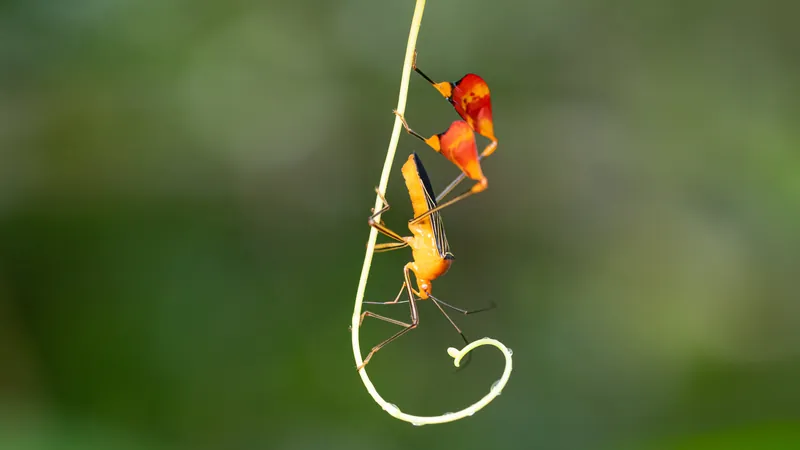
Unraveling Nature's Mystery: Why This Tropical Bug Waves Flags to Stay Alive!
2025-09-10
Author: Jia
Imagine strolling through the lush forests of Panama, only to encounter a bug that waves at you—yes, you heard that right! Scientists at the Smithsonian Tropical Research Institute (STRI) have been captivated by the matador bug (Bitta alipes), a remarkable insect that sports striking, flag-like appendages on its hind legs, engaging in a fascinating leg-waving display.
For a long time, researchers wondered: what’s the purpose of this eye-catching behavior? Initially, they thought it might be a form of sexual selection—perhaps the males were trying to impress females. But when the team put this theory to the test, they found something surprising: both male and female bugs waved their legs, and it had nothing to do with courtship or competition.
The Shocking Discovery!
A groundbreaking study published in Current Zoology by STRI researchers Connor Evans-Blake, Juliette Rubin, and Ummat Somjee has finally shed light on this enigmatic behavior. Their research revealed that these colorful 'flags' aren’t about love; they serve as a clever strategy to deter predators!
In their experiment, the scientists exposed the matador bugs to two types of arthropods: fearsome praying mantids and harmless katydids. The results were striking—bugs dramatically increased their flag-waving by seven times in the presence of mantids, while they barely reacted to the harmless katydids. Even more astonishing, mantids hesitated to attack bugs that were actively waving their legs.
A Broader Evolutionary Strategy?
These fascinating findings provide insight into how waving serves as an anti-predatory tactic, specifically triggered by real threats. The researchers didn’t stop there. They scoured the forests of Panama and even the internet, finding that at least five related species exhibit similar flag-waving behaviors. This suggests a possibly widespread evolutionary tactic among these plant-eating insects.
Interestingly, all these waving insects feast on passionflower vines, known for their toxic properties. These bold movements could be a way for them to flaunt their chemical defenses, but why does waving reduce the chances of getting attacked? The answer remains elusive. Is the waving a sign of toxicity, a visual distraction for predators, or perhaps an intimidating display?
Endless Questions in the World of Insects!
As Ummat Somjee, the senior author of the study, aptly puts it, "We're left with more questions than answers. The beauty of studying insects lies in the sheer diversity of species, most of which are still unexamined. Each close look reveals astonishing behaviors that redefine our understanding of evolution."
Research like this not only tackles quirky questions but also emphasizes the critical role insects play in Earth's biodiversity. They are foundational to terrestrial ecosystems, and yet, a vast majority of their behaviors remain undocumented. By understanding how these remarkable creatures defend themselves, we gain invaluable insight into their evolution and the intricate web of life they inhabit.




 Brasil (PT)
Brasil (PT)
 Canada (EN)
Canada (EN)
 Chile (ES)
Chile (ES)
 Česko (CS)
Česko (CS)
 대한민국 (KO)
대한민국 (KO)
 España (ES)
España (ES)
 France (FR)
France (FR)
 Hong Kong (EN)
Hong Kong (EN)
 Italia (IT)
Italia (IT)
 日本 (JA)
日本 (JA)
 Magyarország (HU)
Magyarország (HU)
 Norge (NO)
Norge (NO)
 Polska (PL)
Polska (PL)
 Schweiz (DE)
Schweiz (DE)
 Singapore (EN)
Singapore (EN)
 Sverige (SV)
Sverige (SV)
 Suomi (FI)
Suomi (FI)
 Türkiye (TR)
Türkiye (TR)
 الإمارات العربية المتحدة (AR)
الإمارات العربية المتحدة (AR)